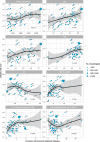Clustering of lifestyle risk factors in relation to suicidal thoughts and behaviors in young adolescents: a cross-national study of 45 low- and middle-income countries
- PMID: 39681898
- PMCID: PMC11622970
- DOI: 10.1186/s44263-024-00055-4
Clustering of lifestyle risk factors in relation to suicidal thoughts and behaviors in young adolescents: a cross-national study of 45 low- and middle-income countries
Abstract
Background: Prior research has reaffirmed lifestyle risk behaviors to cluster among adolescents. However, the lifestyle cluster effect on suicidal thoughts and behaviors (STBs) was unclear among adolescents in low- and middle-income countries (LMICs). No comparison of such associations was conducted across nations.
Methods: Data from 45 LMICs were obtained from the Global School-based Student Health Survey (GSHS) between 2009 and 2019. Lifestyle behavior factors were collected through a structured questionnaire. Suicidal ideation, plan, and attempt were ascertained by three single-item questions. Lifestyle risk scores were calculated via a sufficient dimension reduction technique, and lifestyle risk clusters were constructed using a latent class analysis. Generalized linear mixed models with odds ratio (OR) and 95% confidence interval (CI) were used to estimate the lifestyle-STB associations.
Results: A total of 229,041 adolescents were included in the final analysis. The weighted prevalence of suicidal ideation, plan, and attempt was 7.37%, 5.81%, and 4.59%, respectively. Compared with the favorable lifestyle group, the unfavorable group had 1.48-, 1.53-, and 3.11-fold greater odds of suicidal ideation (OR = 1.48, 95%CI: 1.30-1.69), plan (OR = 1.53, 95%CI 1.34-1.75), and attempt (OR = 3.11, 95%CI 2.64-3.65). Four clusters of lifestyle risk behaviors were identified, namely healthy lifestyles (H-L), insufficient intake of vegetables and fruit (V-F), frequent consumption of soft drinks and fast food (D-F), and tobacco smoking and alcohol drinking (S-A) clusters. Compared with H-L cluster, V-F cluster was associated with 43% and 42% higher odds of suicidal ideation and plan, followed by S-A cluster (26% for ideation and 20% for plan), but not significant in D-F cluster (P > 0.05). D-F cluster was associated with 2.85-fold increased odds of suicidal attempt, followed by V-F cluster (2.43-fold) and S-A cluster (1.18-fold).
Conclusions: Clustering of lifestyle risk behaviors is informative for risk stratification of STBs in resource-poor settings. Lifestyle-oriented suicide prevention efforts should be initiated among school-attending adolescents in LMICs.
Keywords: Adolescent; Cross-national; LMIC; Latent class analysis; Lifestyle risk behavior; Risk stratification; Sufficient dimension reduction; Suicidal attempt; Suicidal ideation; Suicidal plan.
© 2024. This is a U.S. Government work and not under copyright protection in the US; foreign copyright protection may apply.
Conflict of interest statement
Declarations. Ethics approval and consent to participate: All surveys have been approved by local ethics committees, and verbal or written consents were obtained from students and their parents. This study using secondary and de-identified data was considered exempt from approval by the institutional review board at Miami University on June 7, 2022 (ID: 04262e). Consent for publication: Not applicable. Competing interests: The authors declare no competing interests.
Figures



References
-
- Organization WH. Suicide worldwide in 2019: global health estimates. 2021. https://www.who.int/publications/i/item/9789240026643Accessed 5 March 2024.
-
- Organization WH. National suicide prevention strategies: progress, examples and indicators2018. https://www.who.int/publications/i/item/national-suicide-prevention-stra... Accessed 5 March 2024.
-
- Uddin R, Burton NW, Maple M, Khan SR, Khan A. Suicidal ideation, suicide planning, and suicide attempts among adolescents in 59 low-income and middle-income countries: a population-based study. The Lancet Child & Adolescent Health. 2019;3(4):223–33. - PubMed
-
- Jacob L, Stubbs B, Koyanagi A. Consumption of carbonated soft drinks and suicide attempts among 105,061 adolescents aged 12–15 years from 6 high-income, 22 middle-income, and 4 low-income countries. Clin Nutr. 2020;39(3):886–92. - PubMed
Grants and funding
LinkOut - more resources
Full Text Sources
Miscellaneous
